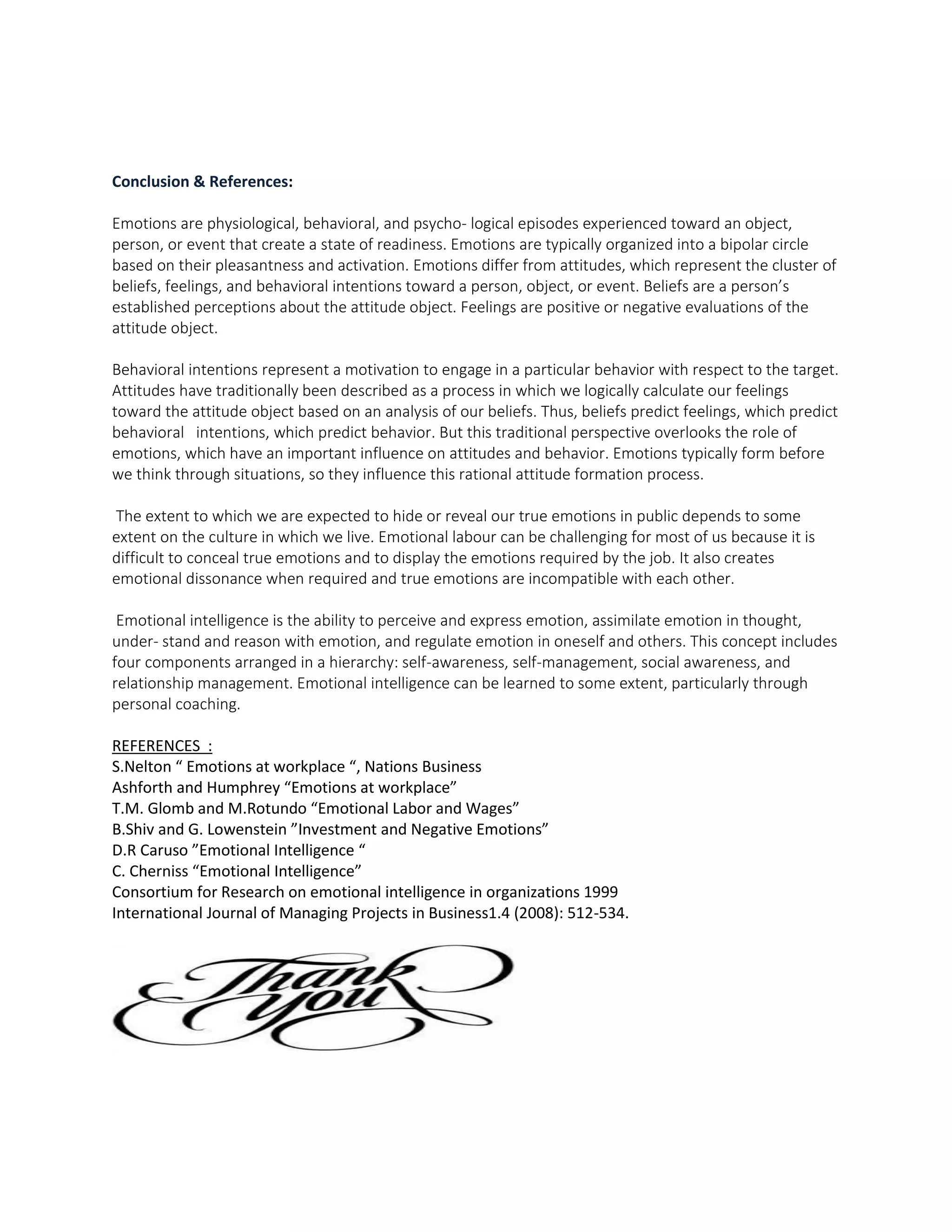The document discusses the significant role of emotions in the workplace, highlighting how they're often misperceived as purely irrational elements contrary to rationality. It emphasizes that emotions are integral to motivation, leadership, and group dynamics, and outlines mechanisms for regulating emotions while also introducing concepts like emotional intelligence and emotional labor. A deeper understanding of emotions can enhance workplace interactions and improve organizational outcomes, suggesting that managing emotions effectively is crucial for both individual and organizational success.
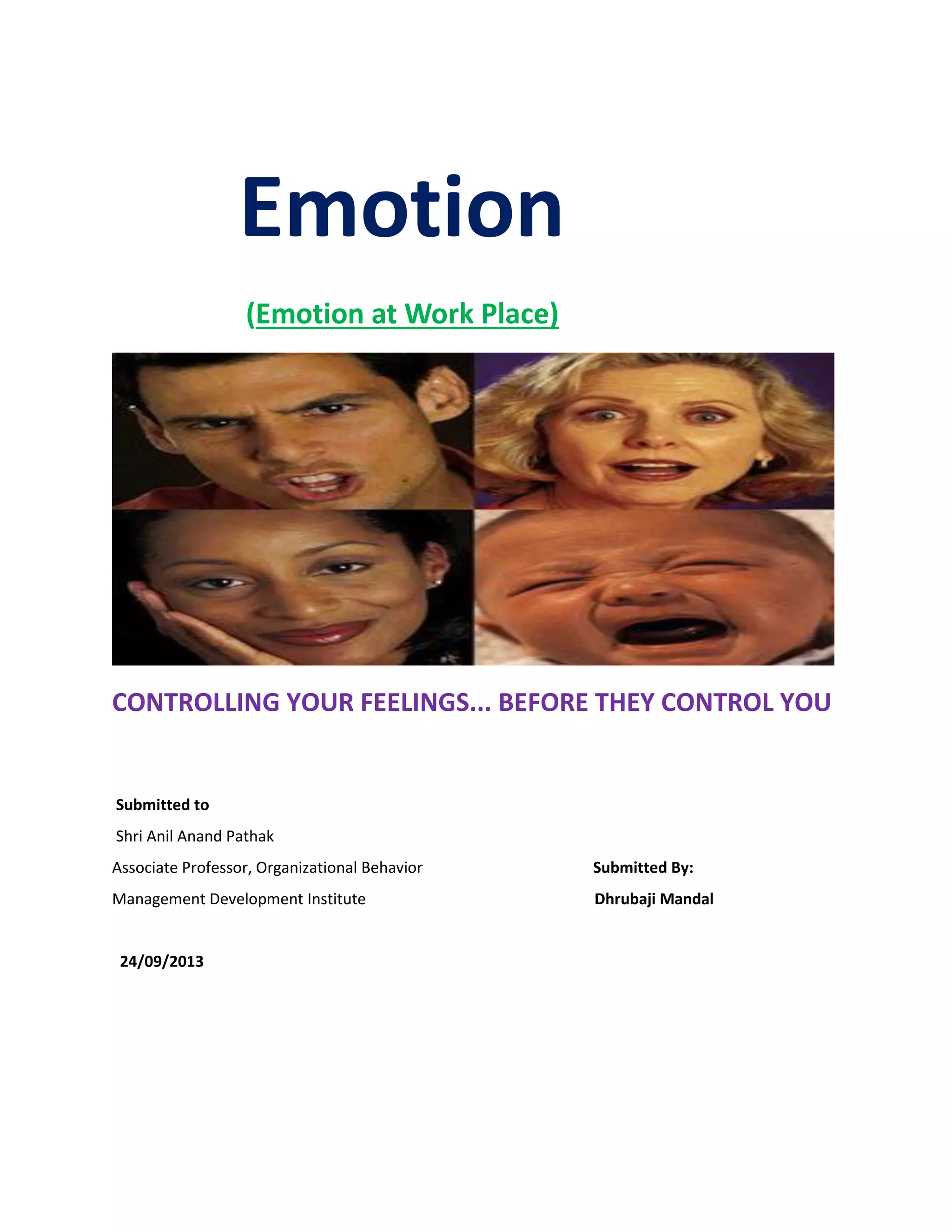
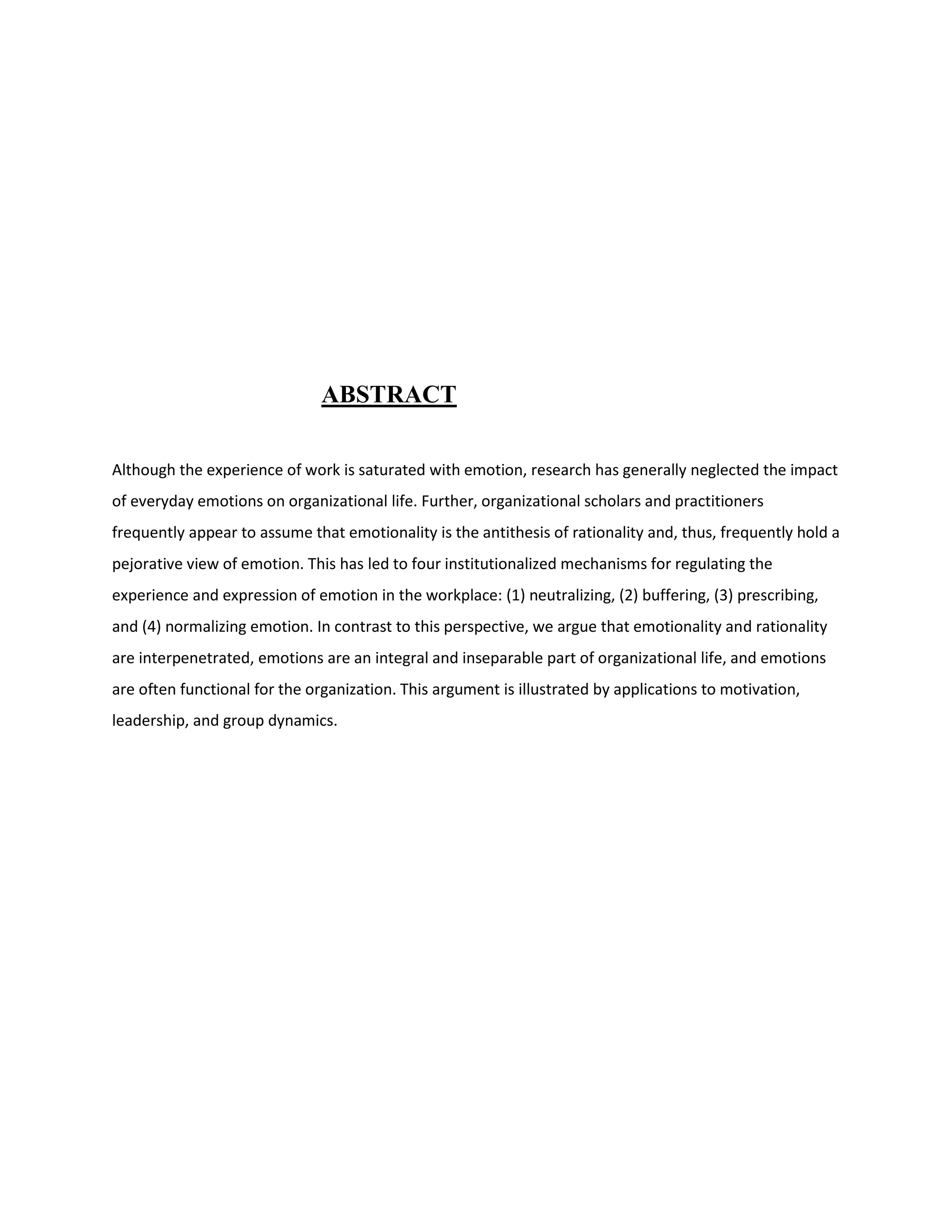
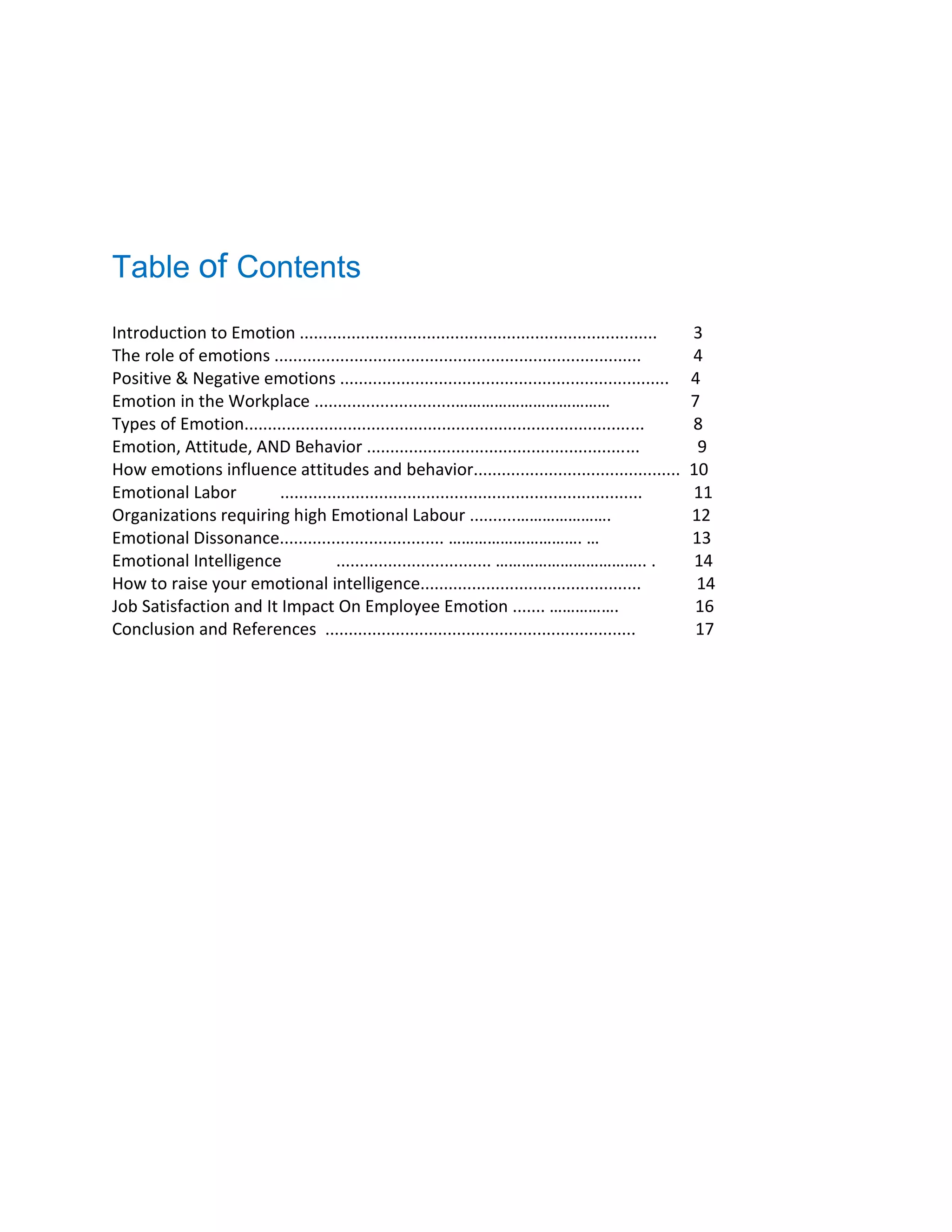
![Introduction to Emotion
What Are Emotions?
Emotions are intense feelings that are directed at someone or something
In psychology and philosophy, emotion is a subjective, conscious experience that is characterized
primarily by psychophysiological expressions, biological reactions, and mental states. Emotion is often
associated and considered reciprocally influential with mood, temperament, personality, disposition,
and motivation, [citation needed] as well as influenced by hormones and neurotransmitters such as
dopamine, noradrenaline, serotonin, oxytocin, cortisol and GABA. Emotion is often the driving force
behind motivation, positive or negative. An alternative definition of emotion is a "positive or negative
experience that is associated with a particular pattern of physiological activity.
“Emotions normally are associated with specific events or occurrences and are intense enough to
disrupt thought processes.” Moods on the other hand, are more “generalized feelings or states that are
not typically identified with a particular stimulus and not sufficiently intense to interrupt ongoing
thought processes”. There can be many consequences for allowing negative emotions to affect your
general attitude or mood at work. “Emotions and emotion management is a prominent feature of
organizational life. It is crucial “to create a publicly observable and desirable emotional display as a part
of a job role.](https://image.slidesharecdn.com/emotionatworkplace-dhrubajimandal-130924082847-phpapp02/75/Project-Report-On-Emotion-At-Work-Place-Dhrubaji-Mandal-4-2048.jpg)
![The role of Emotions
Emotions play such a big role in our lives that there are more than 600 words in English to
describe them verbally, not to mention 43 facial muscles to express them physically. And
although human beings speak more than 6,000 languages, about 90 percent of people across
different cultures have no trouble figuring out if someone is registering happiness, surprise, or
disgust just by looking at the person’s face. We are supersensitive to the slightest shift in
people’s facial expressions, especially if they are registering fear or anger. We are not slaves to
emotional cues and triggers. We can use reason to evaluate our emotions, interpret them, and
even reassess our initial reaction to them. We can soften their impact or shift their meaning.[6] In
other words, we can control our own emotions as well as the effect that other people’s emotions
have on us. In fact, the ability to detect, assess, and control one’s emotions is one of the
predictors of success in relating to the other.
So, somewhat paradoxically, connecting with the other depends on developing a deep
understanding of ourselves — what triggers our strongest emotions, and how the emotions we
show impact others. For example, an executive who understands that looming deadlines bring
out the worse in her won’t schedule an important meeting if she has work piling up. A manager
who knows that talking about certain subjects tends to get him angry will think twice before
reacting to an opinion that would normally set him off
Positive & Negative Emotions
Positive emotions at work such as high achievement and excitement have “desirable effect
independent of a person's relationships with others, including greater task activity, persistence and
enhanced cognitive function. “Strong positive emotions of emotionally intelligent people [include]
optimism, positive mood, self-efficacy, and emotional resilience to persevere under adverse
circumstances. “Optimism rests on the premise that failure is not inherent in the individual; it may be
attributed to circumstances that may be changed with a refocusing of effort
Negative emotions at work can be formed by “work overload, lack of rewards, and social relations which
appear to be the most stressful work-related factors”.[16] “Cynicism is a negative affective reaction to
the organization. Cynics feel contempt, distress, shame, and even disgust when they reflect upon their
organizations” (Abraham, 1999). Negative emotions are caused by “a range of workplace issues,
including aggression, verbal abuse, sexual harassment, computer flaming, blogging, assertiveness
training, grapevines, and non-verbal behavior](https://image.slidesharecdn.com/emotionatworkplace-dhrubajimandal-130924082847-phpapp02/75/Project-Report-On-Emotion-At-Work-Place-Dhrubaji-Mandal-5-2048.jpg)
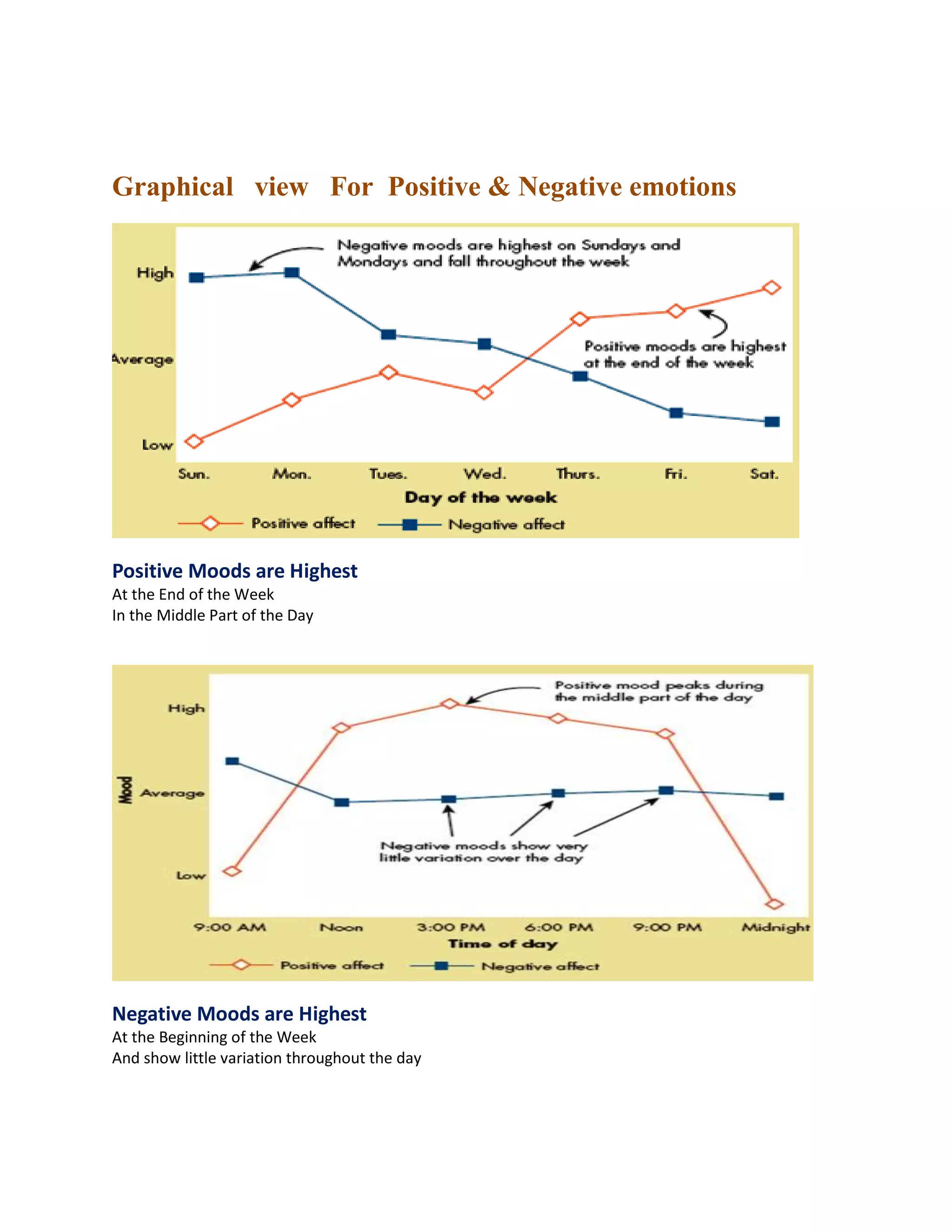
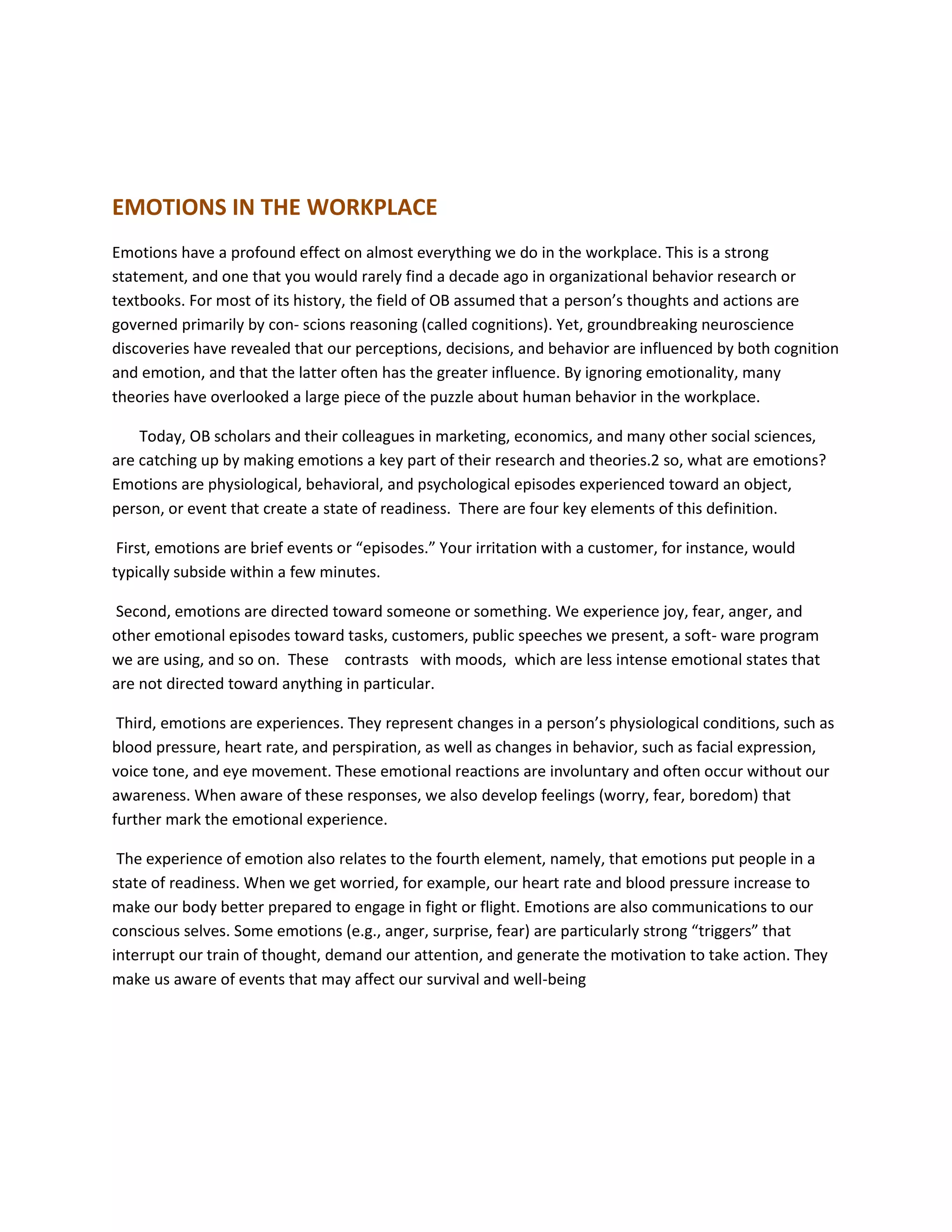
![TYPES OF EMOTIONS
Emotions play such a big role in our lives that there are more than 600 words in English to describe them
verbally, not to mention 43 facial muscles to express them physically. And although human beings speak
more than 6,000 languages, about 90 percent of people across different cultures have no trouble
figuring out if someone is registering happiness, surprise, or disgust just by looking at the person’s face.
We are supersensitive to the slightest shift in people’s facial expressions, especially if they are
registering fear or anger.
We are not slaves to emotional cues and triggers. We can use reason to evaluate our emotions,
interpret them, and even reassess our initial reaction to them. We can soften their impact or shift their
meaning.[6] In other words, we can control our own emotions as well as the effect that other people’s
emotions have on us. In fact, the ability to detect, assess, and control one’s emotions is one of the
predictors of success in relating to the other. So, somewhat paradoxically, connecting with the other
depends on developing a deep understanding of ourselves — what triggers our strongest emotions, and
how the emotions we show impact others.
For example, an executive who understands that looming deadlines bring out the worse in her won’t
schedule an important meeting if she has work piling up. A manager who knows that talking about
certain subjects tends to get him angry will think twice before reacting to an opinion that would
normally set him off.](https://image.slidesharecdn.com/emotionatworkplace-dhrubajimandal-130924082847-phpapp02/75/Project-Report-On-Emotion-At-Work-Place-Dhrubaji-Mandal-8-2048.jpg)
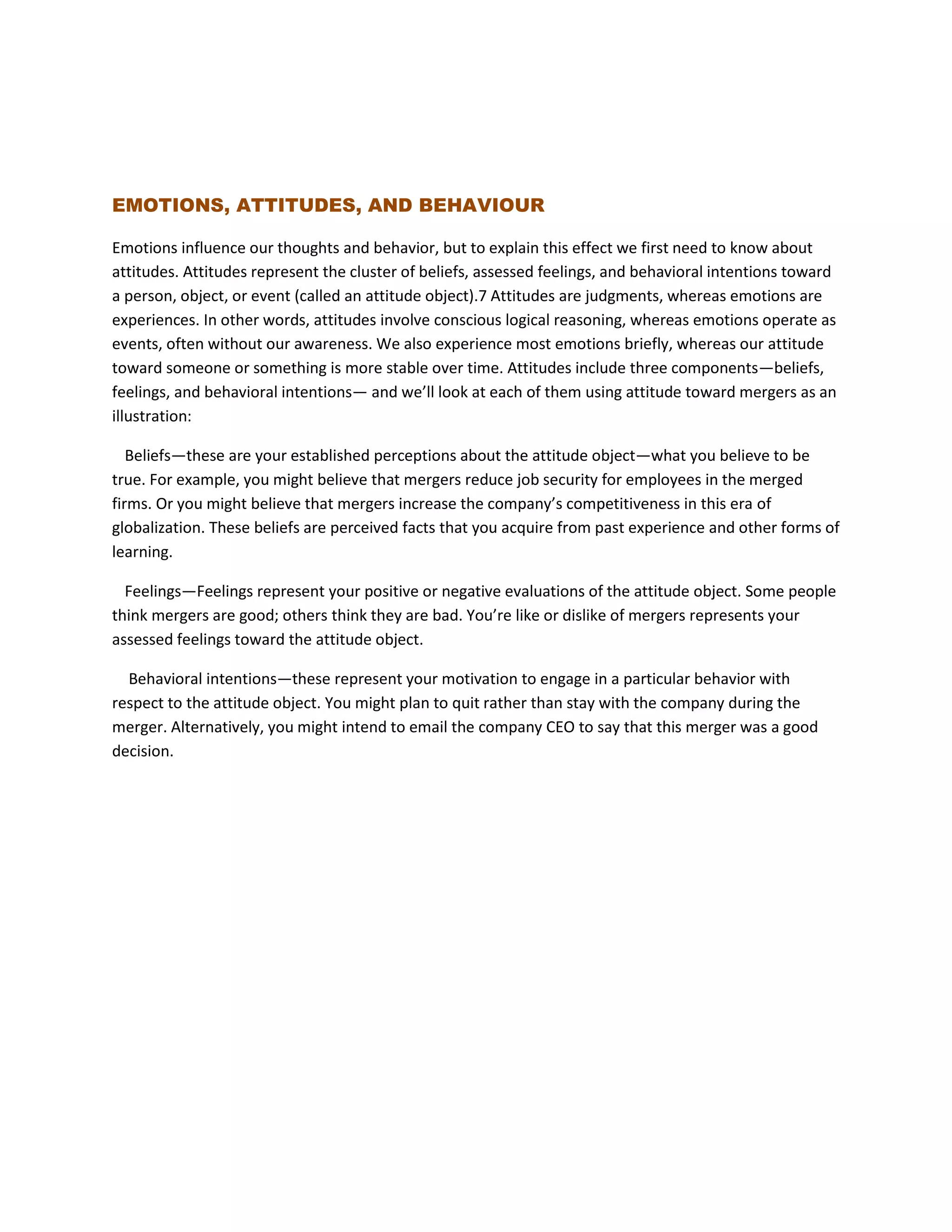
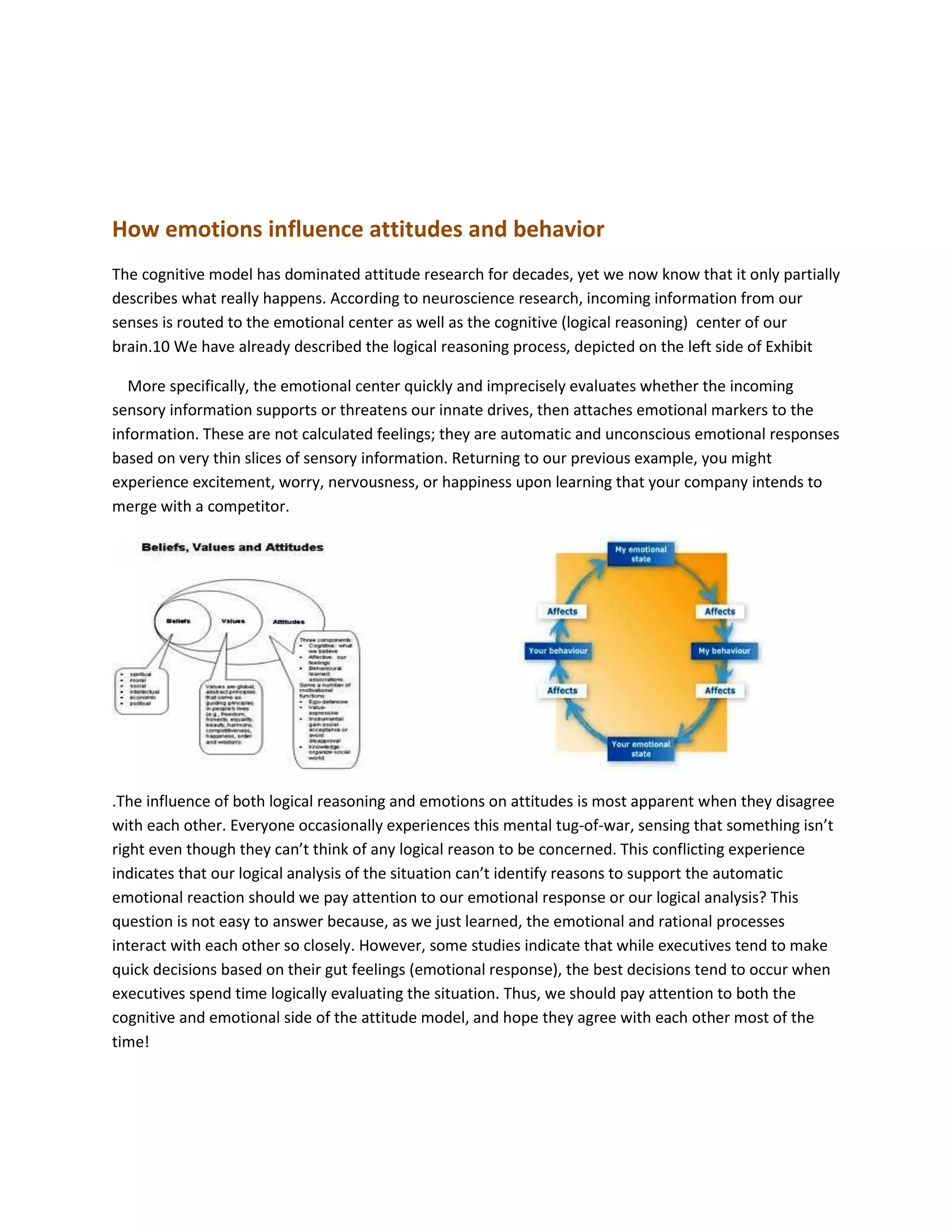
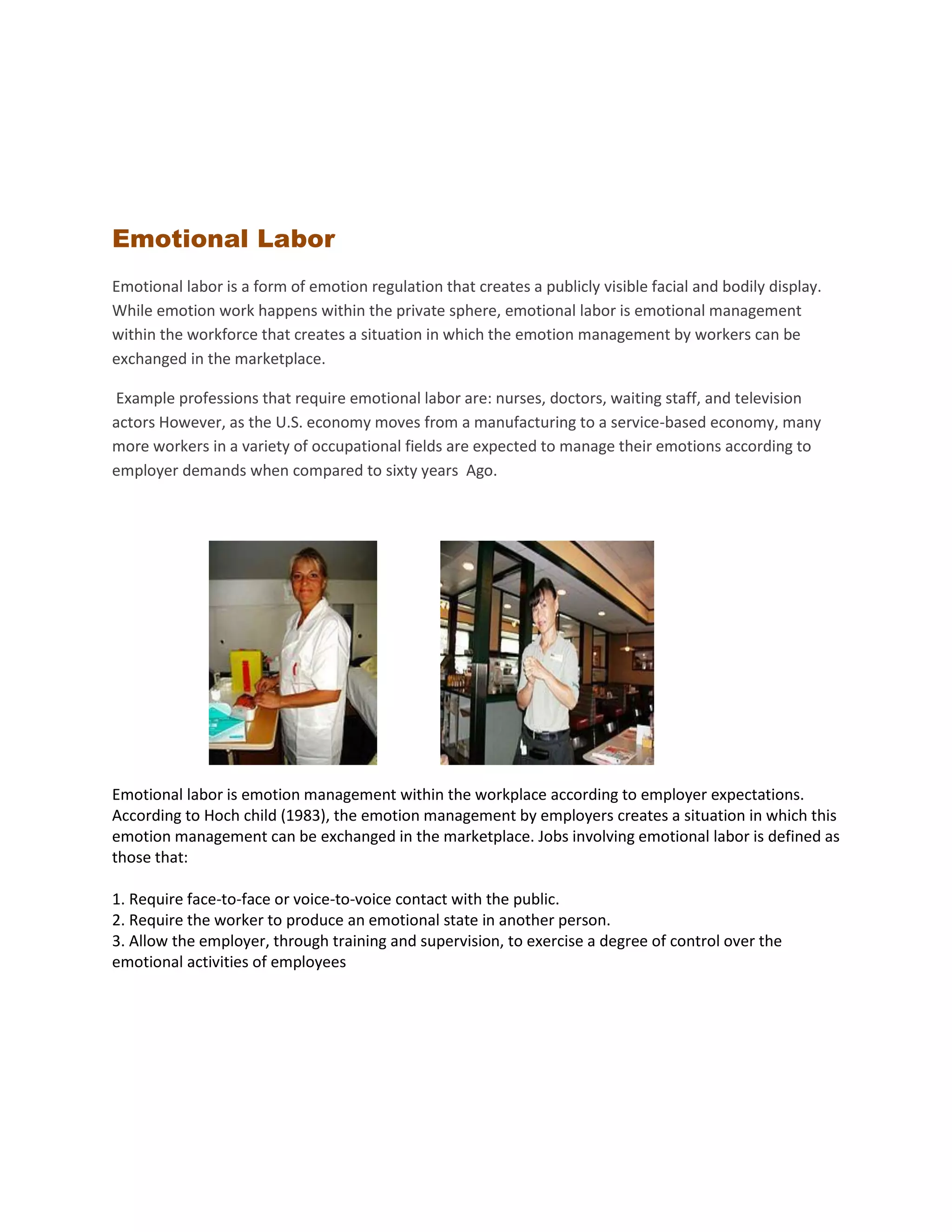
![Organizations requiring high Emotional Labor
Every day, we demand that people display emotions they’re not feeling. Studies indicate that
emotional labor jobs require the worker to produce an emotional state in another person. For example,
flight attendants are encouraged to create good cheer in passengers and bill collectors promote anxiety
in debtors. Research on emotional contagion has shown that exposure to an individual expressing
positive or negative emotions can produce a corresponding change in the emotional state of the
observer. Accordingly, a recent study reveals that employees' display of positive emotions is indeed
positively related to customers' positive affect.
Positive affective display in service interactions, such as smiling and conveying friendliness, are
positively associated with important customer outcomes, such as intention to return, intention to
recommend a store to others, and perception of overall service quality.[23] There is evidence that
emotion labor may lead to employee's emotional exhaustion and burnout over time, and may also
reduce employee's job satisfaction. That is, higher degree of using emotion regulation on the job is
related to higher levels of employees' emotional exhaustion, and lower levels of employees' job
satisfaction.
There is empirical evidence that higher levels of emotional labor demands are not uniformly rewarded
with higher wages. Rather, the reward is dependent on the level of general cognitive demands required
by the job. That is, occupations with high cognitive demands evidence wage returns with increasing
emotional labor demands; whereas occupations low in cognitive demands evidence a wage "penalty"
with increasing emotional labor demand](https://image.slidesharecdn.com/emotionatworkplace-dhrubajimandal-130924082847-phpapp02/75/Project-Report-On-Emotion-At-Work-Place-Dhrubaji-Mandal-12-2048.jpg)
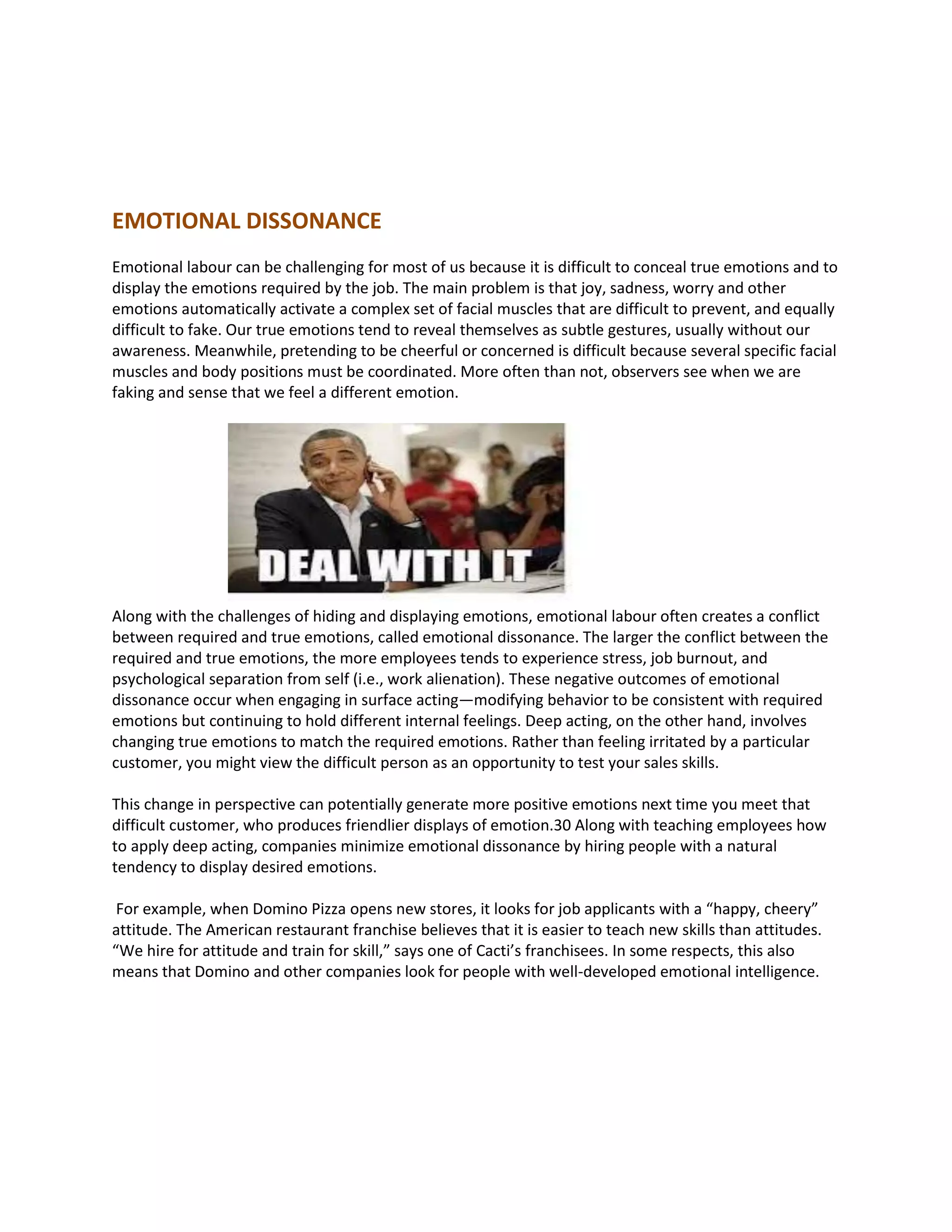
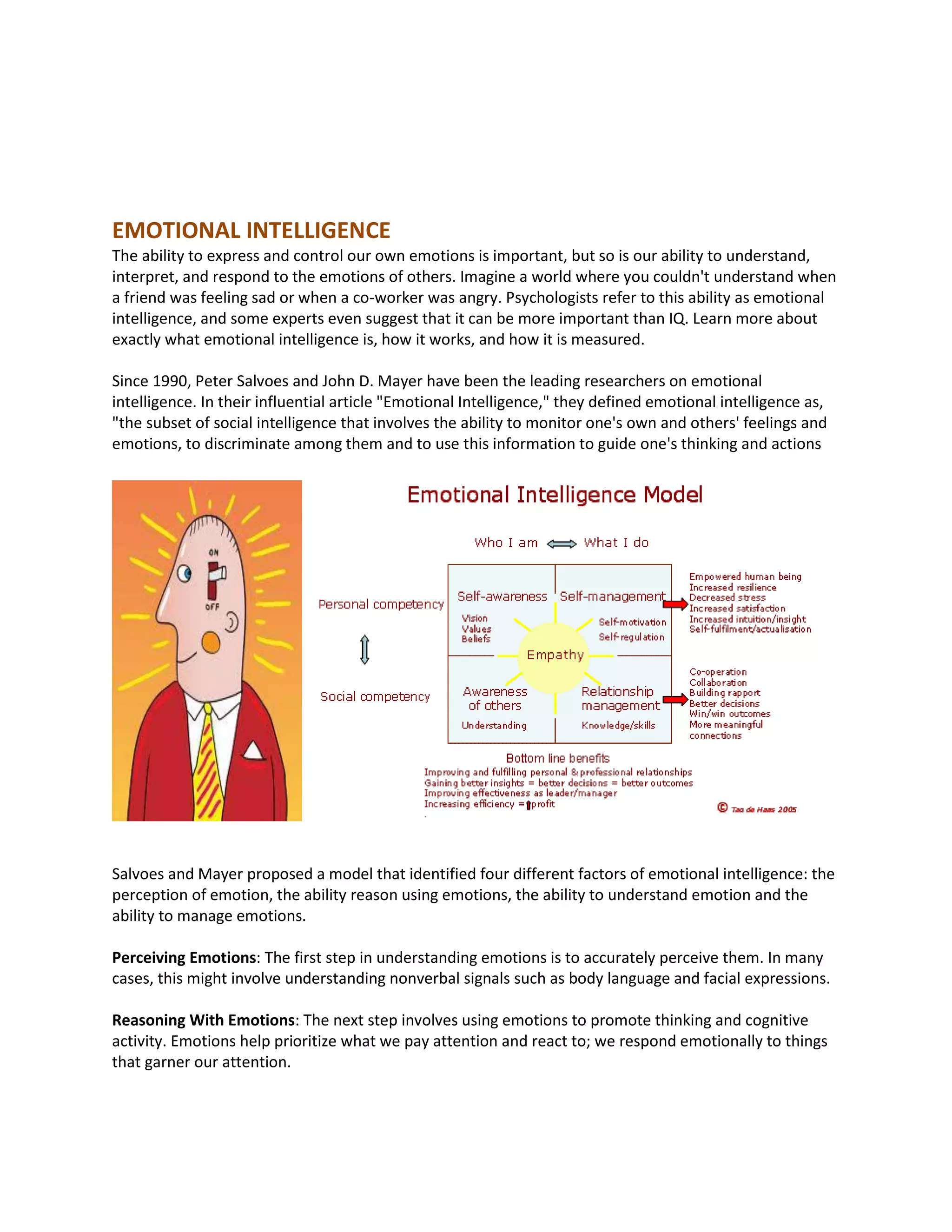
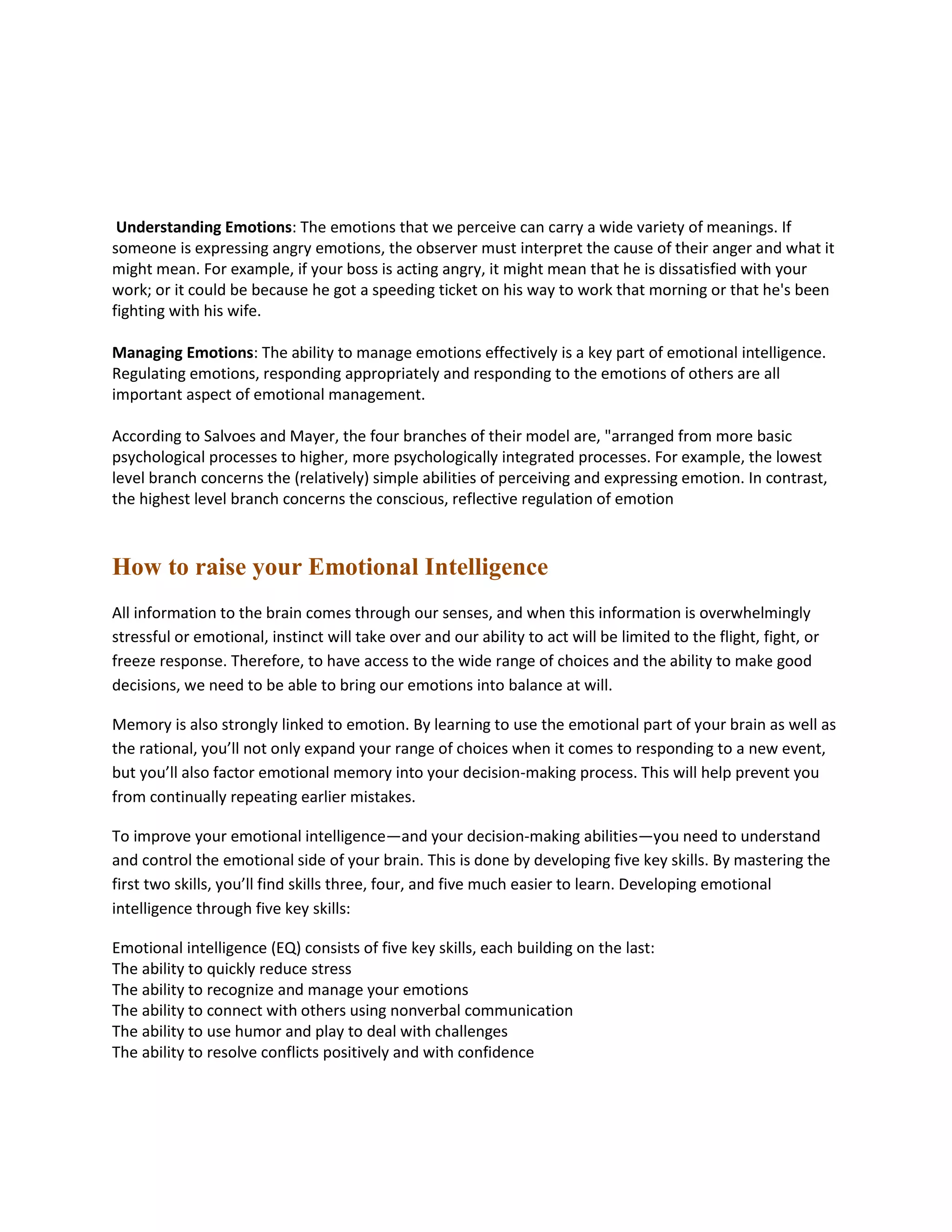
![Job Satisfaction and It Impact On Employee Emotion
Job satisfaction, which is probably the most studied attitude in organizational behavior, represents a
person’s evaluation of his or her job and work context it is an appraisal of the perceived job
characteristics, work environment, and emotional experiences at work. Satisfied employees have a
favorable evaluation of their job, based on their observations and emotional experiences. Job
satisfaction is really a collection of attitudes and Emotion about different aspects of the job and work
context.
An employee is critically affected by their behaviors in the workplace. An employee’s emotions and
overall temperament have a significant impact on his job performance, decision making skills, team
spirit, and leadership and turnover. What employees feel and how they express their emotions affects
their performance. Emotions directly influence decision making, creativity and interpersonal relations.
This research study analyzes the effects of emotions on employees’ job performance and investigates
the relationship between anger, interest, and trust of an individual in the work place with job
performance. Results showed that emotions in the workplace were considered important in relation to
employees’ well-being and job satisfaction only. Anger often leads to aggressions towards colleagues
while sadness leads to dissatisfaction with the job. An emotion like anger, interest trust is not
instantaneous, nor is it prolonged like a mood; rather emotion is a brief episode of synchronized
changes in mind and body which directly affects the employee’s performance.
Job satisfaction is how content an individual is with his or her job. Scholars and human resource
professionals generally make a distinction between affective job satisfaction [1] and cognitive job
satisfaction. Affective job satisfaction is the extent of pleasurable emotional feelings individuals have
about their jobs overall, and is different to cognitive job satisfaction which is the extent of individuals’
satisfaction with particular facets of their jobs, such as pay, pension arrangements, working hours, and
numerous other aspects of their jobs..](https://image.slidesharecdn.com/emotionatworkplace-dhrubajimandal-130924082847-phpapp02/75/Project-Report-On-Emotion-At-Work-Place-Dhrubaji-Mandal-16-2048.jpg)
